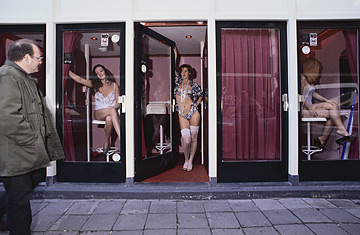
The "red light" district in Amsterdam.
If the city authorities have their way, the widely sold tourist T-shirt proclaiming that "Good boys go to heaven and bad boys go to Amsterdam" will become a relic. Indeed, those bad boys may soon struggle to find their way to the city's fabled red-light district of "storefront" prostitution. Last week one of the main entrepreneurs in the city's perfectly legal sex industry cashed in, selling his properties in the district. The buyer, for $35 million, was a not-for-profit organization backed by the city of Amsterdam. The plan is to convert the buildings in which prostitutes pose in the windows into apartments and more conventional commercial space.
From a strictly entrepreneurial point of view, this is not a good investment. The buyers reckon that the value of the properties may fall by $21 million, a deficit that the municipality would have to fund. But for the city elders, that may be the price of transforming the old city center, which they say has become clogged with undesired and outright criminal activities. While prostitution is legal in the Netherlands, the city has found the trade is a magnet for female trafficking and money laundering. "Our aim is to push back criminal activity, to gain more control over the area", Mayor Job Cohen commented.
Nor is the sex industry Mayor Cohen's only target: He also sees the buyout as a chance to begin clearing out the cannabis-selling coffee shops and what he calls "bad horeca" (the hospitality industry term meaning hotel-restaurant-cafe). The move underpins the strategy of the leftist city government to curb what they see as the excessive proliferation of commerce based on sex, drugs and alcohol, for all of which the city earned its global reputation. While they do not plan to stop the sale of undesirable goods and services altogether, they say it has gotten out of hand.
City Hall's drive to clean up the streets has been going on for some time, but last week's property buyout marks a major escalation — it will eliminate one third of the prostitution rooms in the red-light district, and one fifth of those citywide. Nor is this likely to be the last buyout.
And the authorities appear ready to accept the inevitable impact of the cleanup on tourism. While the canal-lined historic center of Amsterdam is known as the Venice of the north, many visitors are often too overwhelmed by the ready availability of sex and drugs to notice the city's architectural and art treasures. But these tourists — dismissed by alderman Lodewijk Asscher as "vertical drinkers" for their habit of downing cans of Heineken bought at the supermarket while gaping at the prostitutes from the street — are not the ones on which city plans to build its tourism strategy. And, of course, these "bad boys" won't disappear completely, as the red-light district still offers a vast array of prostitution "windows," as they are called. But, with the red lights dimmed, somewhat, the area may once again draw a less hedonistic brand of tourist.
